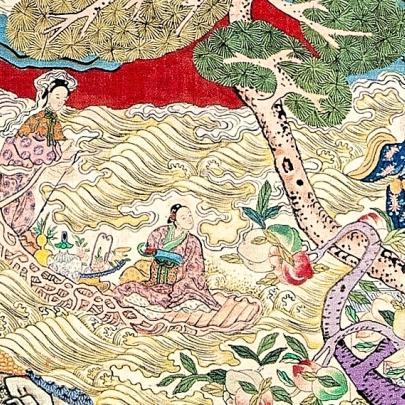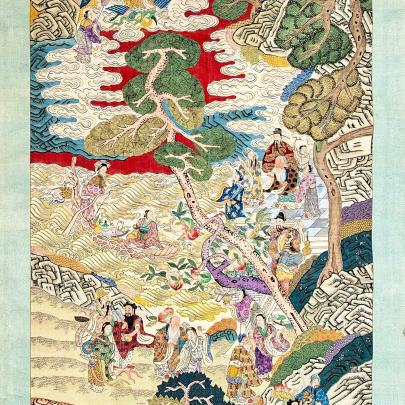Photo credit: British Museum
This exhibition is the work of second year history students at Queen’s University, Belfast.
Between 1500 and 1800, ‘cabinets of curiosities’ were private collections of exotic or unusual objects, displayed in elite homes for the entertainment of invited guests.
An impressive cabinet was a status symbol, suggesting wealth, education, travel and international connections.
Such cabinets were the forerunners of modern museums.
In the early period, cabinets of curiosity typically had no theme or pattern. Instead, diverse objects, like shells, fossils, pictures, coins, stuffed animals, were displayed together to stimulate wonder. By the seventeenth century, some of these collections began to reflect new scientific ideas, systems of classification and the encyclopaedic goal of bringing the whole world under one roof.
Our cabinet of curiosities draws inspiration from this tradition.
Please click on the below images to enlarge.
Chinese Pictorial Scroll
This hand-painted Chinese silk scroll is a storybook of ancient times.
It shows a legend from the Daoist religion. Tapestries like these date to the 3rd century and were originally owned by women. They were artistic displays of the wealth that came from the silk trade. These scrolls were brought out for special occasions like the party shown in the picture
Listen to Leon Zhihao Huang describe the Pictorial Scroll
The Dead Man’s Penny
Memorial plaques such as this were presented to the families of members of the British Army who lost their lives in the First World War.
This penny was given to the family of James McClure, born in Bangor and a member of the 2nd Dragoon Guards. He died on 30 March 1918, aged 56.
Star Gazer by Kathleen Scott
What better way to show your love for your husband than to sculpt a bronze statue in his honour? Kathleen Scott made this miniature copy of her full-size statue in the 1920s, inspired by her Antarctic explorer husband, Captain Robert Falcon Scott, who died travelling back from the South Pole in 1912.
Burmese Executioner’s Sword
This very sword belonged to an executioner in 19th century Burma (now called Myanmar), a country in South-East Asia.
If you look at the sword you can see that the blade has two sharp edges and a weighted tip. This allowed the executions to happen as quickly as possible. Gruesome!
Bamboo Quiver and Poison Arrows
A quiver like this would be used to hunt food or even … your enemies! The poison was made from berries and tree bark and is said to still coat the tips of the arrows to this day. Where are they from? We don’t know the exact location, but arrows of this kind have been used in Africa and Australasia.
Weighing of the Heart - C. 2000 B.C.
The slate panel was used to display events illustrated in the Book of the Dead, an Egyptian funerary text. The scene depicts a scale with the ib, Egyptian word for heart, of the dead (right) being measured against the feather of Maat (left). This feather represents truth and justice, and watching on from the throne is Osiris, Judge of the Dead. At the top of the panel is the Eye of Horus, a symbol for protection and restoration, and an Ankh, representative of eternal life.
Burmese Machete
Used to hack and slash through the jungles of Burma (now Myanmar), the machete was important to the British Army in both world wars. Although Burma supported Britain, the wars resulted in countless economic problems leading to calls for independence, which was achieved in 1948.
Taxidermy Owl
Loughgilly, County Armagh, 1907
Donated by the Misses Stewart in 1953, this majestic Barn Owl was shot and stuffed by the donors’ brother. It resided in their Armagh family home for many years. Unfortunately, with fewer than 30 breeding pairs remaining in Northern Ireland, the future of this iconic creature is in peril.
Opium Pipe (19th-20th century)
A rare Chinese metal pipe used for the recreational smoking of opium. It was donated by the son of Sir John Newell Jordan, British ambassador to China, who was involved in the 19th and early 20th century campaigns to eradicate opium. These pipes are also known as 'dream sticks', alluding to a pipe dream - a metaphor for an unattainable hope.
太白尊 (taibai zun)
Dates to the Kangxi period (1662-1722)
Also known as a chicken-coop vase or as a ji zhao zun.
This Chinese pot was made for a writer’s table. On the base is the mark of the Emperors’ court and the front is decorated with two dragons.
Donated in 1968 by Robert Cromie Jordan.
Shillelagh
A shillelagh is a walking stick around four or five feet in height. It has associations with Irish Folklore, highlighted by shamrock decorations. The name is said to have come from ancient Irish warriors of Shillelagh who used cudgel-style weapons. This example was reputed to have been owned by the Irish Nationalist leader, Charles Stewart Parnell (1846 – 1891).
A Bison Skull
Donated by a member of the Mescalero Apache, Danny Many Horses, as a thank you gift while on a tour of Northern Ireland to promote Native American culture. He showcased stories, dances and traditional native flute songs.
Japanese Airman's Suit
Used by Japanese air-force pilots in the Second World War. The rabbit fur lining was intended to keep pilots warm in winter. The lining contains a concealed pouch which housed a dagger (tachi / aikuni) for the purpose of suicide (seppuku / harakiri) in the event of capture by enemies.

Queen's University Belfast



